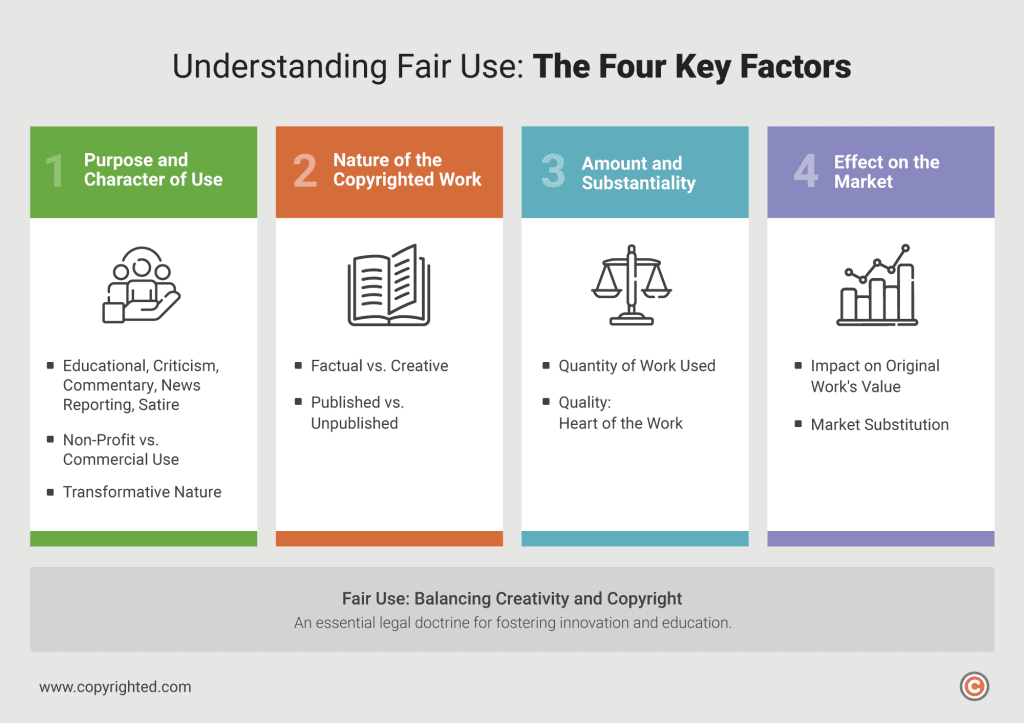If you find yourself wanting to use a song in your video, images on your website, or videos for marketing but are unsure about the copyright boundaries, you’re not alone.
This is a common challenge for content creators and online business owners, often hindering their creative freedom.
This article serves as your guide through the uncertainty. We’ll address your concerns and provide insights into copyright limits.
Let’s simplify the legal aspects, so you can create confidently without worrying about legal complications.
- Understanding fair use helps you determine how much you can copy without the risk of copyright infringement.
- Fair use has limitations, particularly in commercial ventures and when dealing with highly creative works.
- Purpose, nature, amount, and market impact are key factors influencing fair use determinations
Table of Contents
How Much Can You Copy Without Infringing Copyright?
The amount you can copy without infringing copyright depends on the principles of fair use.
Fair use is a legal concept that allows you to use copyrighted material for certain purposes without getting permission from the copyright owner. Copyright and fair use go hand in hand to balance the rights of the original creator with the needs of the public for purposes.
However, the scope of fair use is influenced by factors like the purpose of use and the impact on the original market. So, while there’s flexibility, it’s important to fully understand the complexities of fair use to avoid unintentional copyright infringement.
Four key factors influence fair use determinations. These are the purpose and character of the use, the nature of the copyrighted work, the amount and substantiality of the portion used, and lastly, the effect on the market.
It’s also important to note that fair use isn’t a limitless privilege. There are limitations, particularly concerning commercial use, where the primary purpose is profit-making.
In situations where fair use might be uncertain or challenging, seeking permission from the copyright owner is a wise choice, and one of the best ways to obtain permission is to directly communicate with them.
If you want to use someone’s copyrighted material legally, it’s important to have a good understanding of the fair use doctrine.
Now let’s take a closer look at this helpful but nuanced concept.
The Concept of Fair Use

Fair use, in simple terms, is a legal exception to copyright rules.
Fair use allows you to use someone else’s copyrighted work without the creator’s permission or without facing copyright infringement.
But here’s the catch, there are conditions. These conditions consider factors like the purpose of use, the nature of the work, the amount used, and the impact on the copyright owner’s rights.
According to Section 107 of the Copyright Act of 1986 (17 U.S. Code § 107), using copyrighted material ‘for purposes such as criticism, comment, news reporting, teaching (including multiple copies for classroom use), scholarship, or research,’ is not an infringement of copyright.
Fair use plays an important role in copyright law by striking a balance between protecting the rights of copyright owners and encouraging creativity, innovation, and the free exchange of ideas.
This concept recognizes that not all uses of copyrighted works should require permission, especially when the use serves purposes like criticism, commentary, education, news reporting, and transformative creations.
Essentially, fair use provides a flexible framework that considers the context and purpose of the use.
Now, let me simplify the four factors that determine fair use:
- Purpose and Character of the Use: Fair use leans favorably toward purposes that contribute to education, criticism, commentary, news reporting, or satire. If your use aligns with these objectives, it’s more likely to be considered fair.
- Nature of the Copyrighted Work: Factual works, such as non-fiction or historical content, are generally more amenable to fair use than highly creative and fictional works. This factor recognizes that creative endeavors often require stronger protection.
- Amount and Substantiality of the Portion Used: Generally, the smaller the portion of the copyrighted material you use, the more likely it is to be deemed fair use, however, this isn’t a strict rule. Even if you use a small but critical part of a work, it may still be considered an infringement.
- Effect on the Market: If your use doesn’t harm the potential market or value of the original work, it strengthens the argument for fair use. Essentially, if your use isn’t a substitute that would deprive the copyright owner of income, it’s more likely to be deemed fair.
These factors collectively provide a framework for determining if fair use applies to a specific work. They encourage a thoughtful analysis of how and why copyrighted material is being used, considering the broader implications on creativity, education, and the market.
Fair Use Limitations
While fair use offers flexibility, it doesn’t cover everything, especially if it’s for commercial purposes or if it doesn’t change the original work much. Paying attention to these limits makes sure your creations stay within fair use’s legal and ethical boundaries.
Commercial Use
Fair use has its limits, especially when it comes to commercial endeavors. If your use of copyrighted material is primarily for personal use or commercial purposes, such as making a profit or promoting a product, it becomes less likely to be protected by Fair Use.
Commercial use often tips the scales away from fair use because it implies a potential impact on the market value of the original work.
Transformative Use
One of the key considerations in fair use is the transformative nature of the use. If your work adds new meaning, expression, or purpose to the original material, it is considered transformative.
However, if you’re merely reproducing the original work without significant changes or contributions, the argument for fair use weakens. Fair use favors uses that bring something new to the table, whether through commentary, criticism, parody, or other transformative elements.
Substantiality
Fair use isn’t a license to freely borrow the core or “heart” of a work. Even if you use a small portion, taking the most essential and distinctive part of the original could still lead to copyright concerns.
Courts often assess whether the portion used is necessary for your intended purpose or if it constitutes an excessive and unjustifiable taking. Therefore, be cautious about using the core elements of a work, even if it’s a small fraction.
Now, if you’re curious about what percentage constitutes copyright infringement, it’s important to understand that copyright infringement is not determined by a specific percentage of reproduction but rather by the substantial similarity of the copied material to the original work.
A common misconception is wondering: does copyright infringement require an exact reproduction of the original? In fact, it does not. Even partial use can qualify as infringement if it is deemed substantial and unjustified.
Courts typically assess the quality and importance of the copied portion rather than relying on a quantitative percentage. However, the amount taken may still be a factor in the overall analysis of fair use or infringement.
It’s essential to consider the context, purpose, and impact on the market when evaluating whether the use of copyrighted material constitutes infringement. If in doubt, seeking permission or legal advice is advisable.
When Do You Seek Permission?
Fair use may be a silver lining in the strict world of copyright, but it isn’t a golden ticket for unlimited copying.
So the important question here is, when should you start seeking permission? Here are three scenarios you should consider:
- For-profit ventures: If your project is aimed at commercial gain, it’s advisable to seek permission. Respecting the creators and securing the necessary rights ensures a legal and ethical foundation for your endeavor.
- Uncertain Fair Use: When in doubt about whether your use qualifies as fair use, lean on the side of caution and seek permission. It’s always better to be safe than sorry, especially when the lines of fair use are blurry.
- Highly creative works: Dealing with novels, music, or other highly creative works demands extra caution. Even using a small portion without permission could lead to legal troubles.
It’s also worth noting that some users assume they’re safe from infringement if they cite the original source. But can you avoid copyright by giving credit? The answer is no. Attribution alone does not replace the need for permission or make a use automatically fall under fair use.
3 Ways to Obtain Permissions or Licenses
Now that you’ve chosen the path of caution, here are three ways to obtain permissions or licenses to use a work protected by copyright:
- Direct Communication: The most straightforward avenue is to reach out directly to the copyright owner. Clearly explain your intentions and how you plan to use the material, and discuss any potential terms or fees.
- Licensing Agencies: Opt for licensing agencies or organizations managing the rights of multiple copyright holders. They streamline the process, ensuring you acquire the necessary permissions efficiently and correctly.
- Public Domain and Creative Commons: If the material is in the public domain or covered by a Creative Commons license, you might be in the clear without explicit permission. However, always check the specific terms of the license to ensure compliance.
While fair use offers a valuable framework for using copyrighted material, it isn’t boundless. Recognizing its limits and knowing when to seek permission is key to protecting your business and creative pursuits.
Remember, showing respect for intellectual property not only keeps you within legal boundaries but also nurtures a culture of creativity and collaboration.
Frequently Asked Questions
What is fair use?
Fair use is a legal concept that allows limited use of copyrighted material without permission, primarily for purposes like criticism, commentary, news reporting, teaching, scholarship, or research.
How much can you legally copy from a copyrighted work?
The legality of copying from a copyrighted work depends on fair use principles, considering factors like purpose, nature, amount, and market impact, with no specific percentage limit.
When is it important to seek permission when using copyrighted material?
It’s important to seek permission in situations involving for-profit ventures, uncertain fair use cases, and highly creative works where legal issues may arise.
What are the limitations of fair use?
Limitations of fair use include restrictions on commercial use, the need for transformative use, and avoiding the use of substantial portions or the “heart” of a work.
How can you obtain permissions or licenses?
Permissions or licenses can be obtained through direct communication with copyright owners, utilizing licensing agencies, or considering works in the public domain or covered by Creative Commons licenses.
Can you use material covered by Creative Commons without permission?
Yes, material covered by Creative Commons can be used without explicit permission, but it is essential to check and adhere to the specific terms of the license associated with the material.


